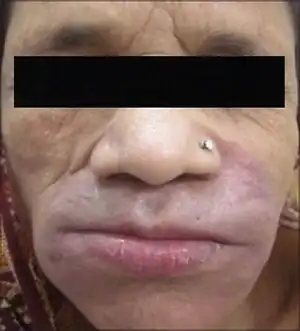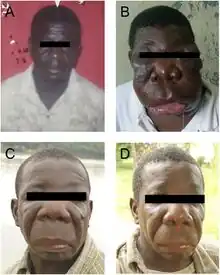Conidiobolomycosis
| Conidiobolomycosis | |
|---|---|
| Other names: Rhinoentomophthoromycosis[1] | |
 | |
| Conidiobolomycosis: Reddish hard swelling over the lower half of face with thickening of the lower lip | |
| Specialty | Infectious disease[2] |
| Symptoms | Firm painless swelling in nose, sinuses, cheeks and upper lips, blocked nose, runny nose, nose bleed[3] |
| Complications |
|
| Usual onset | Slowly progressive[5] |
| Duration | Long term[3] |
| Causes | Conidiobolus coronatus.[3] |
| Risk factors | Tropical forests of South and Central America, West Africa, Southeast Asia[4] |
| Diagnostic method | Medical imaging, biopsy, microscopy, culture, histopathology[4] |
| Differential diagnosis | Soft tissue tumors[3] |
| Treatment | Antifungals, surgical debridement[5] |
| Medication | Itraconazole, Potassium iodide[5] Severe disease: Amphotericin B[4] |
| Prognosis | Longterm morbidity: facial disfigurement,[3] good response to treatment[6] |
| Frequency | Rare, M>F[3] adults>children[4] |
| Deaths | Rare[5] |
Conidiobolomycosis is a long term fungal infection that is typically found just under the skin of the nose, sinuses, cheeks and upper lips.[2][3] It may present with a nose bleed or a blocked or runny nose.[3] Typically there is a firm painless swelling which can slowly extend to the nasal bridge and eyes, sometimes causing facial disfigurement.[5]
Most cases are caused by Conidiobolus coronatus, a fungus found in soil and in the environment in general, which can infect healthy people.[3] It is usually acquired by breathing in the spores of the fungus, but can be by direct infection through a cut in the skin such as an insect bite.[2][3]
The extent of disease may be seen using medical imaging such as CT scanning of the nose and sinus.[3] Diagnosis may be confirmed by biopsy, microscopy, culture and histopathology.[3][4] Treatment is with long courses of antifungals and sometimes cutting out infected tissue.[5] Generally, treatment is with triazoles, preferably itraconazole.[4] A second choice is potassium iodide, either alone or combined with itraconazole.[4] In severe widespread disease, amphotericin B may be an option.[4] The condition has a good response to antifungal treatment,[6] but can recur.[7] The infection is rarely fatal.[5]
The condition is rare, but occurs more frequently in adult males working or living in the tropical forests of South and Central America, West Africa and Southeast Asia.[3][4] The first case in a human was described in Jamaica in 1965.[3]
Signs and symptoms
The infection presents with firm lumps just under the skin of the nose, sinuses, upper lips and cheeks.[3] The swelling is painless and may feel "woody".[7] Sinus pain may occur.[5] Infection may extend to involve the nasal bridge, face and eyes, sometimes resulting in facial disfigurement.[3] The nose may feel blocked or have a discharge, and may bleed.[3]
Cause
Conidiobolomycosis is a type of Entomophthoromycosis, the other being basidiobolomycosis, and is caused by mainly Conidiobolus coronatus, but also Conidiobolus incongruus and Conidiobolus lamprauges,[3] fungi belonging to the order Entomophthorales.[4]
Mechanism
Conidiobolomycosis chiefly affects the central face, usually beginning in the nose before extending onto paranasal sinuses, cheeks, upper lip and pharynx.[4] The disease is acquired usually by breathing in the spores of the fungus, which then infect the tissue of the nose and paranasal sinuses, from where it slowly spreads.[3] It can attach to underlying tissues, but not bone.[3][4] It can be acquired by direct infection through a small cut in the skin such as an insect bite.[2] Thrombosis, infarction of tissue and spread into blood vessels does not occur.[3] Deep and systemic infection is possible in people with a weakened immune system.[3] Infection causes a local chronic granulomatous reaction.[5]
Diagnosis
The condition is typically diagnosed after noticing facial changes.[5] The extent of disease may be seen using medical imaging such as CT scanning of the nose and sinus.[3] Diagnosis can be confirmed by biopsy, microscopy, and culture.[3] Histology reveals wide but thin-walled fungal filaments with branching at right-angles.[4] There are only a few septae.[4] The fungus is fragile and hence rarely isolated.[1] An immunoallergic reaction might be observed, where a local antigen–antibody reaction causes eosinophils and hyaline material to surround the organism.[4] Molecular methods may also be used to identify the fungus.[4]
Differential diagnosis
Differential diagnosis includes soft tissue tumors.[3] Other conditions that may appear similar include mucormycosis, cellulitis, rhinoscleroma and lymphoma.[5]
Treatment and outcome

Treatment is with long courses of antifungals and sometimes cutting out infected tissue.[5] Generally, treatment is with triazoles, preferably itraconazole.[4] A second choice is potassium iodide, either alone or combined with itraconazole.[4] In severe widespread disease, amphotericin B may be an option.[4] The condition has a good response to antifungal treatment,[6] but can recur.[7] The infection is rarely fatal.[5]
Epidemiology
The disease is rare, occurring mainly in those working or living in the tropical forests of West Africa, Southeast Asia, South and Central America,[3] as well India, Saudi Arabia and Oman.[4] Conidiobolus species have been found in areas of high humidity such as the coasts of the United Kingdom, eastern United States and West Africa.[5]
Adults are affected more than children.[4]
History
The condition was first reported in 1961 in horses in Texas.[3] The first case in a human was described in 1965 in Jamaica.[3] Previously it was thought to only infect insects.[3]
Other animals
Conidiobolomycosis affects spiders, termites and other arthropods.[3] The condition has been described in dogs, horses, sheep and other mammals.[10] Affected horses typically present with irregular lumps in one or both nostrils that cause obstruction, bloody nasal discharge and noisy abnormal breathing.[10]
References
- 1 2 Arora, Pooja; Sardana, Kabir; Madan, Anjali; Khurana, Nita (2016). "An Old Woman with a Lump". Indian Journal of Dermatology. 61 (6): 697–699. doi:10.4103/0019-5154.193705. ISSN 0019-5154. PMC 5122299. PMID 27904202. Archived from the original on 2021-08-29. Retrieved 2021-08-26.
- 1 2 3 4 "ICD-11 - ICD-11 for Mortality and Morbidity Statistics". icd.who.int. Archived from the original on 1 August 2018. Retrieved 5 June 2021.
- 1 2 3 4 5 6 7 8 9 10 11 12 13 14 15 16 17 18 19 20 21 22 23 24 25 26 27 28 29 30 31 Chander, Jagdish (2018). Textbook of Medical Mycology (4th ed.). New Delhi: Jaypee Brothers Medical Publishers Ltd. pp. 599–603. ISBN 978-93-86261-83-0. Archived from the original on 2021-08-28. Retrieved 2021-06-06.
- 1 2 3 4 5 6 7 8 9 10 11 12 13 14 15 16 17 18 19 20 21 22 Queiroz-Telles, Flavio; Fahal, Ahmed Hassan; Falci, Diego R.; Caceres, Diego H.; Chiller, Tom; Pasqualotto, Alessandro C. (November 2017). "Neglected endemic mycoses". The Lancet. Infectious Diseases. 17 (11): e367–e377. doi:10.1016/S1473-3099(17)30306-7. ISSN 1474-4457. PMID 28774696. Archived from the original on 2021-08-27. Retrieved 2021-08-25.
- 1 2 3 4 5 6 7 8 9 10 11 12 13 14 Sherchan, Robin; Zahra, Farah (2021). "Entomophthoromycosis". StatPearls. StatPearls Publishing.
- 1 2 3 Gupta, Nitin; Sonej, Manish (March 2019). "JCDR - Conidiobolus coronatus, Conidiobolus incongruus, Entomophthoramycosis". Journal of Clinical and Diagnostic Research. 13 (3). doi:10.7860/JCDR/2019/40142.12701. Archived from the original on 2021-08-29. Retrieved 2021-08-29.
- 1 2 3 Das, Sudip Kumar; Das, Chiranjib; Maity, Amit Bikram; Maiti, Prasanta Kumar; Hazra, Tapan Kanti; Bandyopadhyay, Saumendra Nath (November 2019). "Conidiobolomycosis: An Unusual Fungal Disease—Our Experience". Indian Journal of Otolaryngology and Head & Neck Surgery. 71 (Suppl 3): 1821–1826. doi:10.1007/s12070-017-1182-6. ISSN 2231-3796. PMID 31763253. Archived from the original on 2021-08-28. Retrieved 2021-06-05.
- ↑ Nie, Yong; Yu, De-Shui; Wang, Cheng-Fang; Liu, Xiao-Yong; Huang, Bo (24 August 2021). "A taxonomic revision of the genus Conidiobolus (Ancylistaceae, Entomophthorales): four clades including three new genera". MycoKeys. pp. 55–81. doi:10.3897/mycokeys.66.46575. Archived from the original on 24 August 2021. Retrieved 6 June 2021.
- ↑ Blumentrath, Christian G.; Grobusch, Martin P.; Matsiégui, Pierre-Blaise; Pahlke, Friedrich; Zoleko-Manego, Rella; Nzenze-Aféne, Solange; Mabicka, Barthélemy; Sanguinetti, Maurizio; Kremsner, Peter G.; Schaumburg, Frieder (1 October 2015). "Classification of Rhinoentomophthoromycosis into Atypical, Early, Intermediate, and Late Disease: A Proposal". PLoS Neglected Tropical Diseases. 9 (10). doi:10.1371/journal.pntd.0003984. ISSN 1935-2727. PMID 26426120. Archived from the original on 23 September 2021. Retrieved 13 September 2021.
- 1 2 Sellon, Debra C.; Long, Maureen T. (2007). Equine Infectious Diseases. St. Louis, Missouri: Saunders Elsevier. p. 417. ISBN 978-1-4160-2406-4. Archived from the original on 2021-08-28. Retrieved 2021-06-06.
External links
| Classification |
|---|
_Figure_4.jpg.webp)